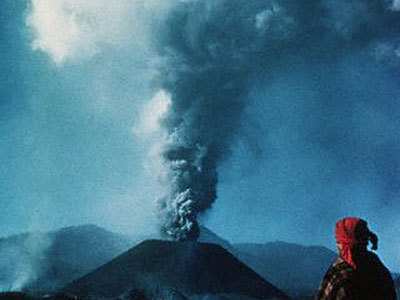Ok, so the Seven Wonders of the Natural world have been announced, and visiting them must be the perfect excuse for a bout of overseas adventure travel. But wait, can't you just look at pictures on Google and videos on You Tube? Of course that's cheaper and easier, but here are a few tasters to convince you to go yourself...
Aurora Borealis

This ballet of neon lights is visible at night in high latitude regions like Iceland, Canada and Scandinavia. It is named after the Roman goddess of dawn, Aurora, and the Greek name for the north wind, Boreas, and occurs most frequently near the equinoxes.
When electrons are expelled by the sun and enter the earth's upper atmosphere, they react with atoms of oxygen and nitrogen, between 20 and 200 miles from the Earth's surface. The colors created depend on which atom the electrons collide with and at which distance from the Earth's surface, and delicately sketch a stunning display ranging from green (the most common color), to red to blue to violet.
These lights are notoriously difficult to capture on camera, which is surely a good reason to see them first hand. And really, you can't argue with being out at midnight, watching a clear and crisp sky with a cup of cocoa warming your paws.
The best spots to observe these entrancing effects include
- Jukkasjärvi, Northern Sweden
- Tromsø , Norway
- Fairbanks, Alaska
- Kangerlussuaq, Greenland

The Grand Canyon doesn't set any records: it is nor the widest, nor the longest, nor the deepest canyon in the world.
So what makes it so special? Perhaps it's simply the sheer beauty of the area, with its reddish rocks and emerald green moats. Looking down into the canyon is like looking deep into the soul of the earth, with each upheaval felt over the years marked indelibly by a strata of rock. In some areas, the layers of rock exposed reveal two billion years of geologic history. Deep crevasses contrast with soaring heights and the millions of visitors welcomed by the canyon each year cannot fail to feel dwarfed by such a sight.
Hiking is, of course, the main activity undertaken by visitors, and hikes offered vary in difficulty and length, from 15 minutes to several weeks: a pretty democratic form of adventure travel, accessible to all.
The Victoria Falls

So named by David Livingstone in honor of his queen, the world's largest sheet of vertical water is more poetically known in the Kololo language as Mosi-oa-Tunya, or, The Smoke that Thunders.
Apart from the latter record set, the falls have several attractive features, one of which is the possibility of safely bathing in Devil's pool at the edge of the drop. When the river is at a safe level, usually between the months of September to December, visitors can swim up to 20in from the edge without falling, thanks to a natural rock wall just below the water.
Another exciting feature is the moonbow which occurs at night when moonlight hits the spray at the bottom of the falls, similar to the better known diurnal rainbow.
Parícutin

(image link: http://13daysofgreen.tumblr.com/post/1370716708/wolfdancer-paricutin-volcano-mexico-paricutin)
This volcano in Mexico is the only one known whose growth was witnessed from its inception. It started as a fissure in a corn field on February 20, 1943, and within a month it was as tall as a five story building. Within a year, it has grown over 1,000ft. After that, it continued to belch quietly, covering the surrounding land with ash and lava until 1952 when the eruption ended.
However, because Parícutin is thought to be a monogenetic volcano, it will probably never erupt again. This means that local people can live without fear of a repetition of the mid-century event and you, dear traveler, can climb into the crater without your eyebrows getting singed.
The Harbor of Rio de Janeiro

This is the only heavily populated Wonder of the Natural World, but is no less spectacular for it (some would say there are other spectacular, ahem, attractions in Rio).
A natural and huge bay, the Harbor of Rio de Janeiro is prettily studded with numerous islands, not unlike Halong Bay in Vietnam. The bay itself is guarded by a series of mountains, some of which plunge dramatically into the sea.
Today, the bay's preservation is at threat. With land at a premium, many areas of the water have been used as dumping grounds for rubbish and are being built over to ease over-crowding.
Nonetheless, the natural beauty of the area remains unquestionable, and if you don't think that's enough, you can always go to the carnival.
Mount Everest
The history of Mount Everest is littered with 'firsts': first ascent (May 29, 1953), first solo ascent (August 20, 1980), fist ascent by a legally blind person (May 25, 2001)... It seems that we humans are obsessed with trying to master this behemoth of a mountain.
Indeed, it presents many challenges, not least the debilitating altitude sickness which has caused the death of so many people who have climbed Everest. Such are the effects of this phenomenon that it takes most climbers up to 12 hours to walk the distance of 1.07 miles from South Col to the summit. The blackest day on Everest was May 11, 1996, in which freak weather conditions caused already poor oxygen levels to plunge by approximately 14%, leading to the deaths of eight people on that day alone.
It is also an expensive business, with trips including gear, guides, oxygen and permits costing upwards of $60,000.
Maybe this one is best appreciated from a distance...
Kelly has seen all 7 wonders of the world and has a passion for convincing others to experience the same.

























































No comments:
Post a Comment
Please leave us some love...and have yourself a groovy day~!! Peaces...xoxo